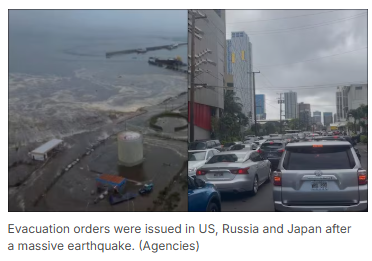8.8 Magnitude Earthquake Triggers Tsunami Across Pacific | Global Alerts Issued
A powerful 8.8 magnitude earthquake near Russia's Kamchatka Peninsula triggered a Pacific-wide tsunami alert, impacting Japan, Hawaii, and the U.S. West Coast. Get full details and global response updates.
BREAKING NEWS


In the early hours of Wednesday, a powerful 8.8 magnitude earthquake struck off Russia’s Far East coast, triggering a tsunami that sent waves across the Pacific. From Japan and Hawaii to Alaska, Mexico, and Pacific Island nations, the quake prompted emergency responses and public alerts.
Despite its massive scale, no large-scale destruction has been reported so far. However, authorities around the Pacific Rim remain on high alert as tsunami risks continue.
🌍 Earthquake & Tsunami Overview
Magnitude: 8.8 (initially recorded as 8.0)
Depth: 20.7 km (13 miles)
Epicenter: 119 km east-southeast of Petropavlovsk-Kamchatsky, Russia
Time: 8:25 a.m. Japan time
Aftershocks: Multiple, with one reaching 6.9 magnitude
🌊 Tsunami Impact Around the Pacific
Russia (Kamchatka Peninsula)
Waves up to 3–4 meters (10–13 feet)
Ports flooded; fishing boats washed away
Emergency power shutoffs; infrastructure under inspection
Japan
Hokkaido recorded 60 cm (2 feet) waves
Smaller waves reported in Tokyo Bay hours later
Transport halted: ferries, trains, airports
Evacuation centers activated, especially in coastal towns like Matsushima
United States
Hawaii:
Traffic jams as residents moved inland
Gov. Josh Green activated Black Hawk helicopters and rescue vehicles
Midway Atoll recorded 6-foot peak-to-trough wave motion
Alaska:
Aleutian Islands saw waves of up to 1.4 feet
Ongoing monitoring by the National Tsunami Warning Center
West Coast (Oregon, California, Washington):
Expected wave height: 1 to 2 feet (30–60 cm)
Public urged to avoid beaches, harbors, and marinas
Canada
British Columbia:
Less than 1-foot tsunami forecast for Vancouver Island
Warnings issued for Langara Island and Tofino
Mexico
Waves expected to hit Ensenada around 2:22 a.m.
Progression southward to Chiapas by 7:15 a.m.
Asia-Pacific Islands
Philippines, Fiji, Samoa, Tonga, Micronesia, Solomon Islands, New Zealand
Issued warnings of:
Unusual currents
Strong and unpredictable wave surges
Urged people to leave beaches and water bodies
🧠 Expert Insight: What Makes Tsunamis So Dangerous?
Dave Snider, tsunami warning coordinator (Alaska), explained:
“A tsunami is not just one wave. It’s a series of powerful waves over a long period of time.”
Key points:
Tsunami waves travel as fast as jet planes in deep water
They slow down and rise near coastlines, causing flooding
Impacts can last hours to more than a day
Dangers include:
Repeated wave surges
Unpredictable water levels
Powerful underwater currents
⚠️ Emergency Measures Taken
Government & Emergency Response Highlights:
Russia: Evacuations, port monitoring, and electrical inspections
Japan: No nuclear abnormalities; Fukushima plant staff sheltered on higher ground
Hawaii: Rescue teams on standby, public urged to stay indoors
U.S. West Coast & Canada: Advisory level alerts; no mandatory evacuations but strong warnings
Pacific Islands: Widespread public safety advisories and evacuations
🔁 Lessons from the 2011 Japan Disaster
The 2025 Kamchatka quake is drawing comparisons to the 2011 Tōhoku earthquake:
20112025Magnitude: 9.0Magnitude: 8.8Over 15,000 deathsNo deaths reported (yet)Triggered nuclear meltdownNo nuclear incidents reportedPoor early warning systemsImproved alerts and response times
Japan’s Response in 2025:
Instant alerts issued
Evacuation centers prepared in advance
Fukushima plant monitored remotely with 4,000 workers moved to safety
🔮 Is the Pacific Ring of Fire Becoming More Active?
The Kamchatka quake is the latest in a series of strong tremors in the region:
Earlier July 2025: Five powerful quakes, the largest measuring 7.4
Possible signs of increased tectonic activity
Emphasizes the need for continued seismic monitoring and international cooperation
📢 Final Thoughts: A Reminder to Stay Prepared
While this event has so far avoided mass devastation, it reinforces critical truths:
Nature’s power remains unpredictable
Early warning systems and public awareness save lives
Preparedness at individual, community, and governmental levels is essential
✅ What You Can Do:
Know your region’s tsunami evacuation routes
Sign up for local emergency alerts
Store an emergency kit with essentials
Follow official guidance promptly during alerts
🔗 Conclusion
The 8.8 magnitude earthquake off Kamchatka is a dramatic reminder that our planet is constantly shifting beneath us. It disrupted coastlines across the Pacific and shook communities from Russia to Hawaii. Though it spared us a tragedy on the scale of 2011, it is a wake-up call for readiness, awareness, and respect for the forces of nature.
